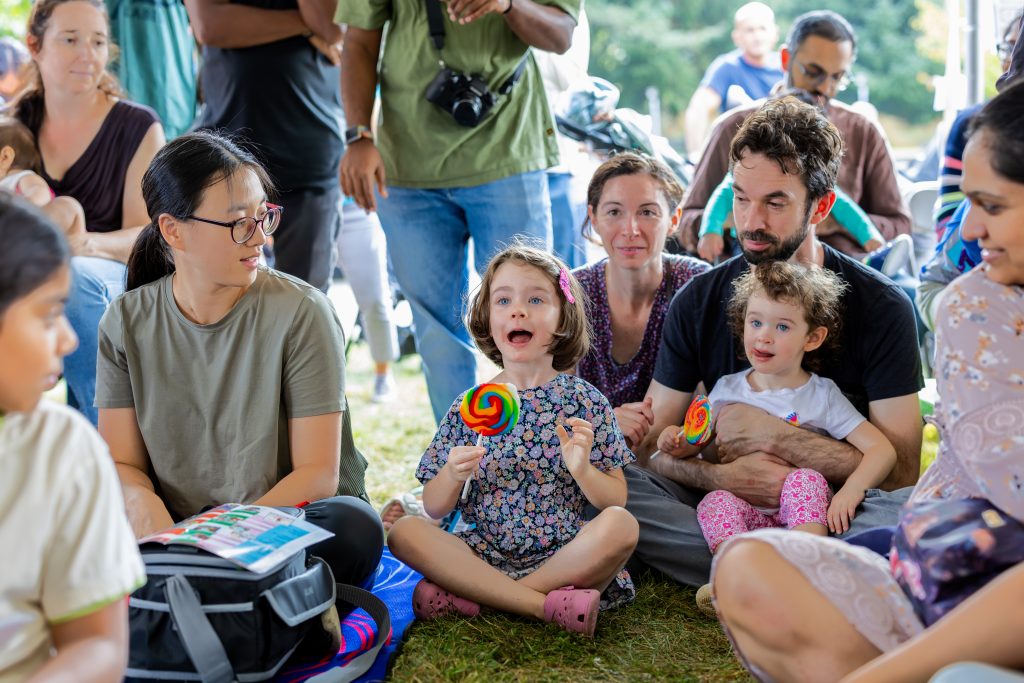
Storytime for Every Mind:
Making Literacy Accessible for All Readers
Michelle Fernandes
September 1, 2025
The increase in the enjoyment level of an activity is proportional to the increase of freedom you give children to show up as themselves.
If you work with young learners, then you know the challenge: keeping kids engaged, focused and genuinely connected to stories. We all want children to develop a lifelong love of reading—to lose themselves in books, to think critically and to make sense of an increasingly complex world. But what happens when storytime just doesn’t hold their attention anymore? When reading feels more like a struggle than a joy?
Back in 2023, at our 15th anniversary Telling Tales Festival, we began asking ourselves some hard questions. Why is it so difficult to get kids reading on their own? Why do some children have trouble sitting still for a story? And even when they’re listening, how can we help them connect with the plot, characters or deeper themes?
In rethinking our programming with the support of an occupational therapist (OT), two guiding principles shaped our approach. First, we embraced the idea that when children struggle to engage, it’s often due to a skills gap—not a lack of interest or motivation. Children do well when they can. Second, we recognized that neurodivergent children need freedom to play and explore stories in their own ways. All play is okay.
Through Telling Tales’ Inclusive Tales Research Project, we uncovered a simple but powerful insight: the increase in the enjoyment level of an activity is proportional to the increase in freedom you give children to show up as themselves. This realization informed our new Inclusive Tales Model, transforming how we design our events and interact with young audiences.

By meeting kids where they are—across all reading levels, learning styles and neurotypes—Telling Tales is building a more inclusive, engaging and joyful literary experience. It’s storytelling reimagined, and it’s helping every child discover their place in the world of books.
As producers of Canada’s leading literary festival for children, our first imperative as part of the Inclusive Tales Research Project was to address a major reason kids struggle with traditional storytime: self-regulation. Self-regulation is being able to match your energy to the energy required for an activity. For many learners, that’s just not possible without additional support.
It’s easy to focus on why there’s an energy mismatch. Is a child’s overactivity or distractibility due to neurodivergence, the result of a great nap or maybe a sugar rush? While understanding a child’s individual neurotype is essential in one-on-one settings, when you’re welcoming over 12,000 attendees to a public event, it requires a different approach.
Through a series of piloted events and extensive research in collaboration with our OT, we identified three strategies to adapt to our festival programming for readers of every kind.
1. Play, Play, and Play some more!
At Telling Tales, all play isn’t just okay—it’s encouraged. Play is not just a break between stories—it’s a gateway into them. One of the most significant shifts in our programming was reimagining how children enter a story—not just by sitting and listening, but by moving, exploring, and choosing their own way in.
To support this, each reading tent featured a carefully curated mix of age-appropriate activities designed to promote self-regulation. This helped children get into the right energy space to connect meaningfully with the stories being told.
For our youngest participants (ages 0–6), we offered traditional sitand- listen storytime with a twist. Alongside readings, children could engage in loose parts sorting games—matching objects by colour, size and shape. Sessions were kept to 15 minutes, with open activity time between presentations to reset and refocus.
For the 9–12 age group, hands-on workshops helped bring literature to life. In a poetry session led by author Carol-Ann Hoyte, kids created poems using visual media—from invisible ink revealed by heat to blackout poetry crafted with book pages and Sharpies. These interactive formats sparked creativity and let kids choose their own poetic path.
In the 13+ Young Adult Tent, teens explored stories through crafts like beading friendship bracelets, making cut-out collages, and themed colouring—all offered alongside author panels and writing workshops. By providing a relaxed, low-pressure environment, teens could engage at their own pace and in their own way.
At the heart of all of this was one goal: to give young readers the freedom to choose how and when to engage. Whether during the story or after, when we gave the freedom of choice and considered differing abilities, the joy and connection multiplied.
2. Good Vibrations: Tuning into audience energy needs
Running a festival that meets audiences’ energy needs takes creativity and care. Creating high-energy space to support attendees at a book festival requires presenting storytelling in multidisciplinary and exciting ways like drama and dance. While reading is an often quiet endeavor, creating lower-energy spaces at a busy festival requires designating and maintaining sensory-safe quiet areas. These zones were designed and spread out throughout the festival, with different age groups and needs in mind.
Each tent included a nearby Regulation Station—an area stocked with age-appropriate fidget tools and calm activities children could explore at any time.
What we discovered was powerful. High-energy and more sensory sensitive kids alike stayed engaged during storytime, picked up books and were able to interact with authors while genuinely enjoying themselves in their own ways and speeds. And all of this amidst a large, lively event. We had done it. That was the goal.
We were proud of the progress—but our journey toward true accessibility wasn’t over yet.
3. ASL in Action: Storytime Adapted for Everyone
Accessibility goes beyond wheelchair-accessible washrooms and ramps at entrances. Thankfully, our festival is committed to inclusion in all its forms. Our prime location at the Royal Botanical Gardens in Burlington, Ontario, allows us to offer a mostly wheelchair- and power chair-accessible experience for all guests (grass can provide some challenges).
As we continued our exploration into disabilities and accommodations through the Inclusive Tales Research Project, we recognized a significant gap in storytelling opportunities for the Deaf and hard-of-hearing community. That insight led to a meaningful partnership with Silent Voice Canada. In our first year working together, we were proud to present 18 performances with ASL interpretation across our Main Stage, Ages 6-8 Tent and Ages 9-12 Tent, as well as added guest services and audience outreach.
Through our work with Silent Voice, we also learned that ASL translation for children comes with added layers of complexity. Many children who are still learning ASL cannot keep up with standard adult-level interpretation. To support these young learners, we implemented a dual interpreter model. One hearing interpreter sat in the audience, translating the presentation directly, while a Deaf performer on stage observed what the hearing interpreter signed to them and adjusted the ASL to better suit the children in the audience.

ASL learners span a wide range of literacy levels and age groups, and our goal was to meet every learner exactly where they were so that enjoyment could increase in tandem. With this model in place, ASL learners of all ages and skill levels were able to participate fully, making these performances truly designed for every mind.
At Telling Tales, we’ve learned that when children are free to engage in ways that match their minds and bodies, stories come alive. From play-based activities and sensory-safe zones to thoughtful ASL interpretation, we’re not just reading books—we’re building belonging. Literacy, when made accessible, becomes joyful, empowering and truly for every mind.
Meet the Author

Michelle Fernandes is the Communications Coordinator for Telling Tales, a non-profit inspiring children’s love of reading through festivals, school programs and community events.
For more information about The Teaching Librarian, please refer to the Terms of Reference.
Recent Articles
The Ottawa Indie Bookstore Crawl
The Ottawa Indie Bookstore Crawl Danny Neville September 1, 2025 Share on facebook Share on linkedin As school library folks, you’ve likely heard about Canadian …
View from a Tree Nominee
View from a Tree Nominee Marty Chan September 1, 2025 Share on facebook Share on linkedin As a kids’ author, I thought I had seen …
CANSCAIP: School Library Heroes
CANSCAIP: School Library Heroes Lisa Loffredi The Canadian Society of Children’s Authors, Illustrators and Performers (CANSCAIP) is a not-for-profit national arts service organization founded in 1977. …


